Lerblokke som Bundsediment i danske Farvande
DOI:
https://doi.org/10.34194/raekke4.v4.7003Abstract
The exchange of water between the Baltic and the ocean through the Danish Sounds gives rise to a system of currents. The individual currents are dependent on outflow, tides, meteorological factors, bottom relief, etc. The rate of the surface currents is regularly measured at the light-ships, while the rate of the bottom currents is only measured occasionally. Bottom currents are accordingly rather unknown, and few average velocities have been published.
The present paper deals with a particular bottom deposit observed in Danish Sounds. It consists of large lumps or »boulders« of clay (e.g. Tertiary clay, Interglacial clay or Glacial till) embedded in normal marine sand and gravel. A »clay boulder« conglomerate of this kind was exposed for a short time at the bottom of the Lillebælt during the construction of the Lillebælt Bridge (fig. 1). The »clay boulders« were in this case derived from the Tertiary Lillebælt clay.
Recent investigations of the Storebælt and The Sound with the Kullenberg Piston Core Sampler revealed that a similar sediment is found also in these areas. However, the cores generally display alternation of glacial till and marine shell bearing sand, because the diameter of the Piston Corer is smaller than that of the majority of the »till boulders«. (fig. 2).
The clay boulder conglomerates on the present sea bottom of the Danish Straits are evidence of rather strong submarine erosion and redeposition. It is suggested that erosion is particularly efficient along the submarine channels, and that the deep hollows are mainly due to submarine erosion.
Downloads
Published
Issue
Section
License
This article is distributed under a CC-BY 4.0 licence, permitting free redistribution and reproduction for any purpose, even commercial, provided proper citation of the original work. Author(s) retain copyright over the article contents.


